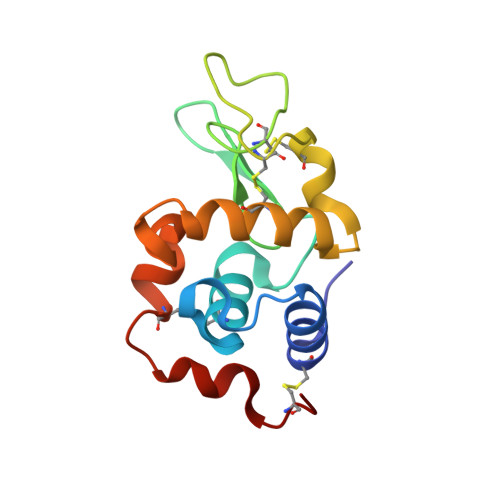Chemical conversion of cisplatin and carboplatin with histidine in a model protein crystallized under sodium iodide conditions.
Tanley, S.W., Helliwell, J.R.(2014) Acta Crystallogr F Struct Biol Commun 70: 1127-1131
- PubMed: 25195879
- DOI: https://doi.org/10.1107/S2053230X14013995
- Primary Citation of Related Structures:
4OWA, 4OWB - PubMed Abstract:
Cisplatin and carboplatin are platinum anticancer agents that are used to treat a variety of cancers. Previous X-ray crystallographic studies of carboplatin binding to histidine in hen egg-white lysozyme (HEWL) showed a partial chemical conversion of carboplatin to cisplatin owing to the high sodium chloride concentration used in the crystallization conditions. Also, the co-crystallization of HEWL with carboplatin in sodium bromide conditions resulted in the partial conversion of carboplatin to the transbromoplatin form, with a portion of the cyclobutanedicarboxylate (CBDC) moiety still present. The results of the co-crystallization of HEWL with cisplatin or carboplatin in sodium iodide conditions are now reported in order to determine whether the cisplatin and carboplatin converted to the iodo form, and whether this took place in a similar way to the partial conversion of carboplatin to cisplatin in NaCl conditions or to transbromoplatin in NaBr conditions as seen previously. It is reported here that a partial chemical transformation has taken place to a transplatin form for both ligands. The NaI-grown crystals belonged to the monoclinic space group P21 with two molecules in the asymmetric unit. The chemically transformed cisplatin and carboplatin bind to both His15 residues, i.e. in each asymmetric unit. The binding is only at the N(δ) atom of His15. A third platinum species is also seen in both conditions bound in a crevice between symmetry-related molecules. Here, the platinum is bound to three I atoms identified based on their anomalous difference electron densities and their refined occupancies, with the fourth bound atom being a Cl atom (in the cisplatin case) or a portion of the CBDC moiety (in the carboplatin case).
- School of Chemistry, Faculty of Engineering and Physical Sciences, University of Manchester, Brunswick Street, Manchester M13 9PL, England.
Organizational Affiliation:























